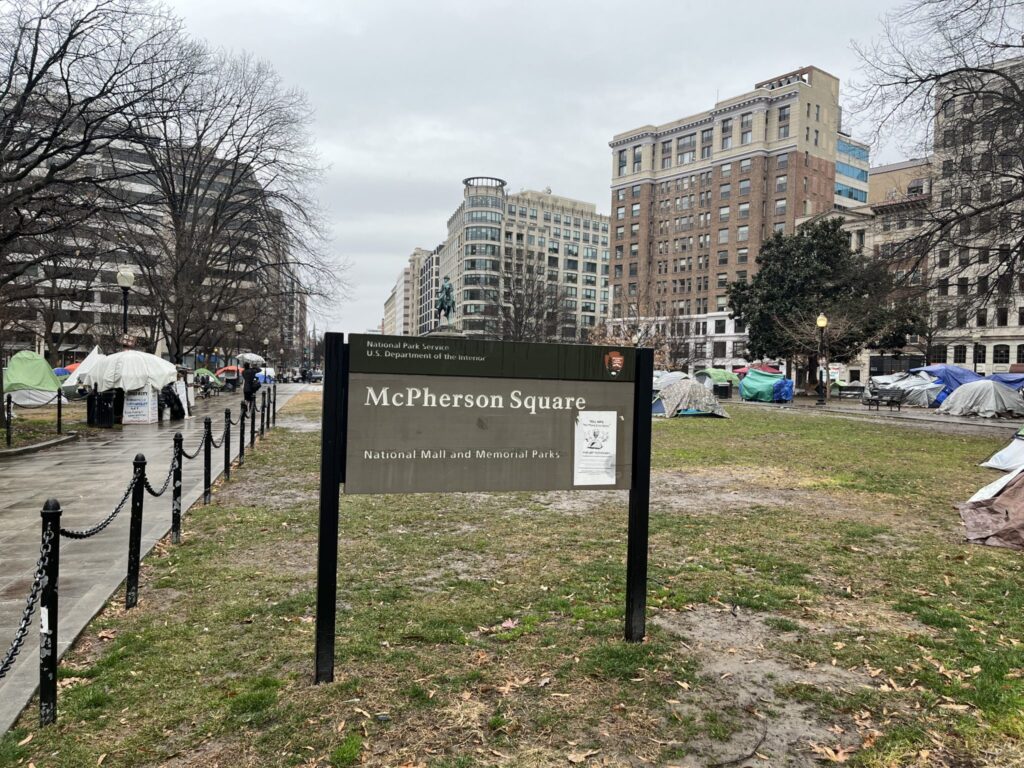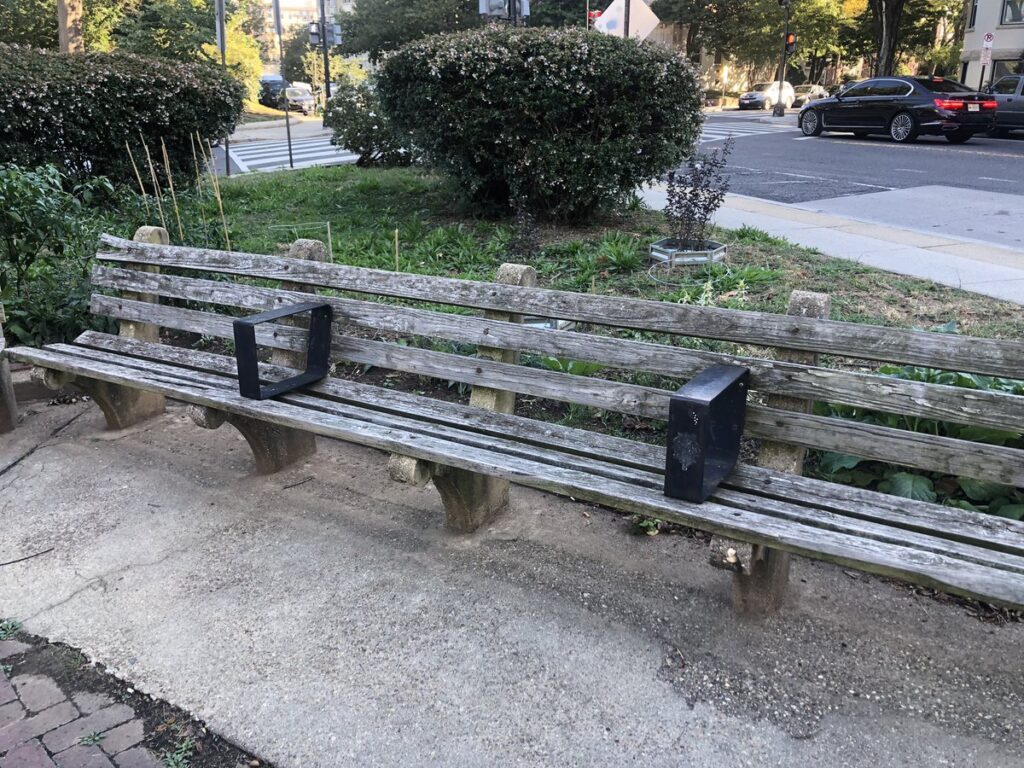Close observers of D.C.’s homeless services are predicting the city’s shelters may be full by midyear as a potential rise in demand for beds coincides with the shuttering of some shelter programs.
Next week, the National Park Service (NPS) plans to remove unsheltered people living in an encampment at McPherson Square. The District cleared smaller encampments in Logan Circle and Anacostia on Tuesday. At the same time, D.C. is halting funds for the temporary housing provided via the Pandemic Emergency Program for Medically Vulnerable Individuals (PEP-V), and is slated to close two low-barrier shelters for renovation by the summer. All told, the city will lose a total of 787 beds over the next year, potentially leaving residents with nowhere to go.
The city’s shelters for individuals have been under stress often in the last six months, according to nightly reports. In addition to accommodating thousands of migrants bused to D.C. by Republican governors, they also have served unhoused people driven inside by early cold spells before the city opened its hypothermia sites. In recent weeks, shelters have had around 100 open beds each night — somewhat tight, but workable. But some observers of D.C.’s homeless services system worry shelters will soon reach capacity, as they discussed at a D.C. Interagency Council on Homelessness (ICH) meeting on Feb. 1.
“I think we’re fine right now — but, with PEP-V and the other shelters they said they are closing at that meeting, that’s problematic,” said Kate Coventry, deputy director of legislative strategy at the D.C. Fiscal Policy Institute and a member of the ICH.
D.C. operates 10 low-barrier shelters, which provide beds on a first-come, first-served basis throughout the year to anyone experiencing homelessness. Collectively, the shelters offer about 840 beds for men, 340 beds for women, and 40 beds for LGBTQ+ individuals in the only city-funded shelter where occupancy isn’t based on a gender binary. During hypothermia season, which generally lasts from Nov. 1 to April 1, the D.C. Department of Human Services (DHS) opens overflow shelter sites to account for the identified gap between demand and shelter beds — this year, about 250 beds.
Upcoming renovations will decrease the number of low-barrier shelter beds available for single men. In April, the city will begin long-planned construction on the Pat Handy Legacy shelter downtown, temporarily eliminating 55 beds during the project. By the summer, that deficit will grow to 122 beds, as Blair shelter near the H Street NE corridor closes for renovations this summer and fall.
Meanwhile, the city’s hypothermia sites will close on April 1. While the sites don’t operate as full-service shelters, they do provide a place to sleep for people when the traditional shelters are full. On Feb. 5, people slept in over 200 of the 250 overflow beds. Though not everyone who sleeps inside during hypothermia season seeks shelter in the warmer months, some ICH members expressed concern at the meeting that the closure of those shelters this spring will leave people scrambling with fewer year-round shelter beds to move into.
Given that about 100 shelter and overflow beds are available each night, the city is not facing a shelter capacity issue, a DHS spokesperson said.
The scale of the problem
Through the CARES Act, the federal government provided state and local jurisdictions throughout the country with funding to operate non-congregate shelters during the pandemic. In D.C., several PEP-V hotels opened to serve people experiencing homelessness with severe COVID-19 risk. The program could accommodate up to 665 people at once, and D.C. routinely relied on those beds to provide shelter to all residents who wanted it.
DHS announced in early January that the city would soon close the PEP-V program, as the federal government discontinued its portion of the funding. PEP-V is not accepting any new residents and will be phased out “over the next year,” according to the DHS announcement. DCist reported that Unity Health Care, which operates the PEP-V sites, is aiming to move all 532 people currently living in PEP-V into housing by September.
But advocates such as Wes Heppler, counsel to the Legal Clinic for the Homeless, remain concerned about the fate of PEP-V residents. Some people living in PEP-V have been matched to a housing voucher but are in the months-long process of securing the voucher and finding housing. PEP-V participants who are not connected to housing resources might turn to the low-barrier shelter system, Heppler said, given that the city has not confirmed whether everyone will be allowed to stay in PEP-V until they have permanent housing. Even if they can, he added, the city will ultimately see a loss of over 600 shelter beds.
“The need for that kind of non-congregate facility and that kind of case management services, that doesn’t end,” Heppler said.
Meanwhile, it is increasingly likely that the National Park Service’s efforts to clear all encampments by the end of 2023 will increase shelter demand. Last week, NPS accelerated its plans to close the McPherson Square encampment, deciding to do so on Feb. 15 rather than sometime in April. Only 15 of the over 70 people living there are currently connected to a housing voucher, and none have actually moved into their own apartment, according to a DHS spokesperson. More recently, Ward 2 Councilmember Brooke Pinto said an additional 15 residents had “begun engagement” with service providers to obtain vouchers.
Both NPS and D.C. personnel have told McPherson Square residents they can stay in a low-barrier shelter after NPS closes their encampment. A Twitter account run by McPherson residents has repeatedly pushed back on this suggestion, arguing D.C. is making it difficult for them to find a suitable place to stay given high shelter occupancy and the closing of the PEP-V program.
Though many residents at McPherson may choose not to go to a shelter, “it’s important to make sure that we actually have the beds that we offer,” Coventry said.
Many encampment residents avoid going to shelters because they worry about their privacy and safety at the sites, which are often crowded and sometimes in poor condition. PEP-V’s hotel rooms have been a welcome solution for some who traditionally avoid shelters, but residents at the encampments closed this month won’t have the choice to live there under current policy.
“It’s kind of a perfect storm. If you’re closing PEP-V at the same time you’re trying to get a lot of individuals to come indoors into shelters, that’s not a good combination,” Heppler said.

What can D.C. do?
Government officials say that all PEP-V and encampment residents who are matched to a Permanent Supportive Housing (PSH) voucher are eligible to live in Bridge Housing, which can provide a transition apartment while residents wait to find an apartment to rent with their voucher. In addition to designated Bridge Housing, the city can also use hotel rooms at PEP-V, isolation and quarantine sites to house people waiting for their vouchers, a DHS spokesperson said. There are currently 14 vacancies in Bridge Housing.
Other proposed solutions fall into two categories: either pause the PEP-V and encampment closures or find a way to make more room in the shelters.
Heppler proposed that the city extend PEP-V with local money while working to identify and set up an alternative non-congregate shelter, thereby allowing current participants to stay until they have permanent housing and filling vacant slots. Residents of encampments, meanwhile, say the city and NPS should wait to close any sites until the city can guarantee housing, or at least adequate shelter, for those who would be displaced. At McPherson, residents said late last week that they had not had the chance to apply for housing yet, despite the city’s claims that residents were refusing to engage service providers. Ward 1 Councilmember Brianne Nadeau has also called for the NPS to delay closing the McPherson encampment.
The city could also reduce the need for shelter by ensuring people who are eligible for vouchers move into housing as fast as possible, Coventry said. About 1,700 individuals are eligible for available housing vouchers but are somewhere in the application and housing search process, many of whom may live in shelters, encampments or PEP-V hotels.
But if there’s no way to provide housing, Coventry said the city may need to look at ways to increase the number of shelter beds. She suggested partnering with some of the locations that open temporary shelters in the winter to continue operating into the spring and summer.
At the beginning of the pandemic, recognizing the need for new non-congregate shelter options, a group of citizens who have experienced homelessness urged the city to adopt their Vacant-to-Virus Reduction (V2VR) proposal. The V2VR plan, which some residents are seeking to revive, would move unhoused people into vacant units through subsidies to developers and landlords — somewhat like a streamlined version of housing vouchers, with incentives funded by mechanisms such as tax increment financing to encourage housing providers to participate. This plan, like continuing PEP-V, would require significant local funding.
This article has been updated from the print version to include comment from DHS.
This article was co-published with The DC Line.
Annemarie Cuccia covers D.C. government and public affairs through a partnership between Street Sense Media and The DC Line. This joint position was made possible by The Nash Foundation and individual contributors.








